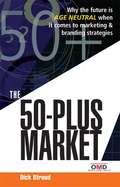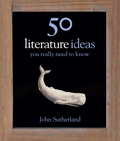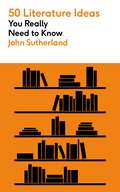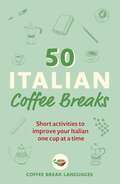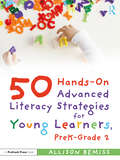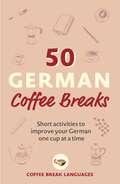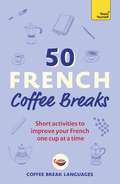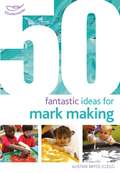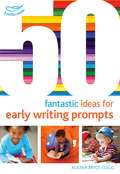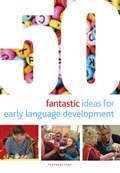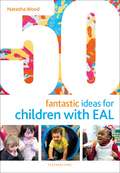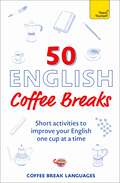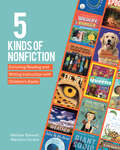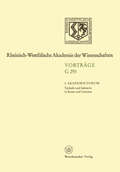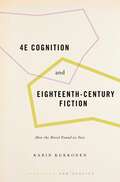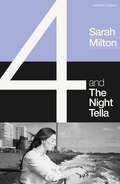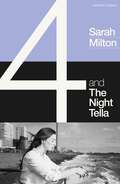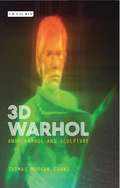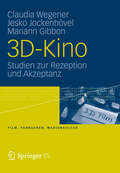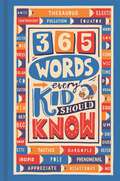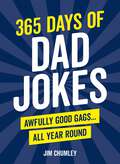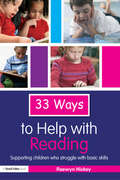- Table View
- List View
The 50-Plus Market: Why the Future is Age-Neutral When it Comes to Marketing and Branding Strategies (1st edition) (PDF)
by Dick StroudChallenging marketing's core assumptions about the effects of ageing on consumer behaviour, The 50 Plus Market provides a fresh approach to the way companies interact with their older customers. It explains how the principles of age-neutral marketing will ensure companies capture the vast expenditure generated by this affluent group.This compelling book analyses all aspects of marketing to this age group. Supported by research from OMD, one of the largest and most influential media communications specialists in the world, The 50 Plus Market is essential reading for those wishing to refine their marketing strategies.
50 Literature Ideas You Really Need to Know (50 Ideas You Really Need to Know series)
by John SutherlandLiterature suffers from appearing both deceptively easy and dauntingly difficult. We all like to think we can read a novel and understand what 'genre', 'style' and 'narrative' mean, but do we really understand them fully and how they can enrich our reading experience? How should we approach the works of great writers such as William Shakespeare, T.S. Eliot, Charles Dickens and Jane Austen? 50 Literature Ideas you Really Need to Know provides a clear, opinionated and thorough overview of literary theories from the apparently familiar to the decidedly unfamiliar. Packed with insights and examples from both classic and popular works, it is a book that will delight anyone who has ever been mystified by literary jargon and wants to gain a deeper enjoyment of reading and writing.
50 Literature Ideas You Really Need to Know (50 Ideas You Really Need to Know series)
by John SutherlandIn a series of 50 accessible essays, John Sutherland introduces and explains the important forms, concepts, themes and movements in literature, drawing on insights and examples from both classic and popular works.From postmodernism to postcolonialism, William Shakespeare to Jane Austen , 50 Literature Ideas You Really Need to Know is a complete introduction to the most important literary concepts in history.
50 Italian Coffee Breaks: Short activities to improve your Italian one cup at a time (Coffee Break Series)
by Coffee Break LanguagesTransform your down time into 'do time'.The most successful language learners create a habit of studying on a regular basis. 50 Italian Coffee Breaks makes it easy to master a simple routine of improving your Italian by effortlessly integrating it with your calming daily ritual - from a 5-minute espresso to a 15-minute latte.Organised by 5, 10 and 15 minutes, these 50 varied and lively activities - from anagrams and idiom challenges to recipes and quotations - are created for high-beginner to intermediate adult and young-adult learners and designed to keep you motivated while building your skills in key areas. · Reading comprehension · Writing skills · Grammar confidence · Translation abilities · Vocabulary expansion · Cultural awareness By practising Italian in a fun and relaxed way in the time you have, you will stay on track to achieve your language-learning aspirations. So, pick up your preferred brew and this practical book, and make learning the most pleasant and productive part of your busy day. For 15 years Coffee Break Languages has helped make it possible for millions of people to learn a language in a way that fits into their everyday life: whether that's while walking the dog, at the gym, or on their coffee break!Teach Yourself has collaborated with Coffee Break Languages to bring their brilliant method to a wider audience by producing their first-ever printed product. All the activities are written by long-time teachers of the language in Coffee Break's characteristically friendly and conversational style. It's the perfect complement to your studies.The activities are levelled for high-beginner to low-intermediate learners: CEFR A2-B1 and ACTFL Intermediate-low/mid
50 Hands-On Advanced Literacy Strategies for Young Learners, PreK-Grade 2
by Allison Bemiss50 Hands-On Advanced Literacy Strategies for Young Learners, PreK–Grade 2 is your go-to resource for lessons, strategies, and activities to foster the key skills and thinking strategies needed to excel in literacy. The hands-on, minds-on literacy explorations in this book are designed to feel a lot like play, but are rooted in the foundational literacy practices that all young learners need. Packed with engaging and helpful reproducibles, each activity is thoughtfully laid out with skill(s), materials, introduction, hands-on task, and reflection sections to maximize student learning. Instructions on how to scaffold experiences for a wider range of ages and developmental readiness levels make this resource imminently flexible. Ideal for learners in grades PreK–2, this book is for teachers, curriculum coaches, parents, librarians, and community educators looking to work on target literacy skills.
50 Hands-On Advanced Literacy Strategies for Young Learners, PreK-Grade 2
by Allison Bemiss50 Hands-On Advanced Literacy Strategies for Young Learners, PreK–Grade 2 is your go-to resource for lessons, strategies, and activities to foster the key skills and thinking strategies needed to excel in literacy. The hands-on, minds-on literacy explorations in this book are designed to feel a lot like play, but are rooted in the foundational literacy practices that all young learners need. Packed with engaging and helpful reproducibles, each activity is thoughtfully laid out with skill(s), materials, introduction, hands-on task, and reflection sections to maximize student learning. Instructions on how to scaffold experiences for a wider range of ages and developmental readiness levels make this resource imminently flexible. Ideal for learners in grades PreK–2, this book is for teachers, curriculum coaches, parents, librarians, and community educators looking to work on target literacy skills.
50 German Coffee Breaks: Short activities to improve your German one cup at a time (Coffee Break Series)
by Coffee Break LanguagesTransform your down time into 'do time'.The most successful language learners create a habit of studying on a regular basis. 50 German Coffee Breaks makes it easy to master a simple routine of improving your German by effortlessly integrating it with your calming daily ritual - from a 5-minute espresso to a 15-minute latte.Organised by 5, 10 and 15 minutes, these 50 varied and lively activities - from anagrams and idiom challenges to recipes and quotations - are created for high-beginner to intermediate adult and young-adult learners and designed to keep you motivated while building your skills in key areas. · Reading comprehension · Writing skills · Grammar confidence · Translation abilities · Vocabulary expansion · Cultural awareness By practising German in a fun and relaxed way in the time you have, you will stay on track to achieve your language-learning aspirations. So, pick up your preferred brew and this practical book, and make learning the most pleasant and productive part of your busy day. For 15 years Coffee Break Languages has helped make it possible for millions of people to learn a language in a way that fits into their everyday life: whether that's while walking the dog, at the gym, or on their coffee break!Teach Yourself has collaborated with Coffee Break Languages to bring their brilliant method to a wider audience by producing their first-ever printed product. All the activities are written by long-time teachers of the language in Coffee Break's characteristically friendly and conversational style. It's the perfect complement to your studies.The activities are levelled for high-beginner to low-intermediate learners: CEFR A2-B1 and ACTFL Intermediate-low/mid
50 French Coffee Breaks: Short activities to improve your French one cup at a time (Coffee Break Series)
by Coffee Break LanguagesTransform your down time into 'do time'.The most successful language learners create a habit of studying on a regular basis. 50 French Coffee Breaks makes it easy to master a simple routine of improving your French by effortlessly integrating it with your calming daily ritual - from a 5-minute espresso to a 15-minute latte.Organised by 5, 10 and 15 minutes, these 50 varied and lively activities - from anagrams and idiom challenges to recipes and quotations - are created for high-beginner to intermediate adult and young-adult learners and designed to keep you motivated while building your skills in key areas. · Reading comprehension · Writing skills · Grammar confidence · Translation abilities · Vocabulary expansion · Cultural awareness By practising French in a fun and relaxed way in the time you have, you will stay on track to achieve your language-learning aspirations. So, pick up your preferred brew and this practical book, and make learning the most pleasant and productive part of your busy day. For 15 years Coffee Break Languages has helped make it possible for millions of people to learn a language in a way that fits into their everyday life: whether that's while walking the dog, at the gym, or on their coffee break!Teach Yourself has collaborated with Coffee Break Languages to bring their brilliant method to a wider audience by producing their first-ever printed product. All the activities are written by long-time teachers of the language in Coffee Break's characteristically friendly and conversational style. It's the perfect complement to your studies.The activities are levelled for high-beginner to low-intermediate learners: CEFR A2-B1 and ACTFL Intermediate-low/mid
50 Fantastic Ideas for Mark Making (50 Fantastic Ideas)
by Alistair Bryce-CleggChildren are naturally drawn to mark-making. Long before they pick up a pencil or a paintbrush, they will experiment with making marks using their own bodies as well as various found objects that they come across in day-to-day life. By collecting together a whole host of ideas for different mark-making utensils, as well as exploring numerous substances and surfaces that children can mark-make on and in, this book supports both individual and group mark-making.
50 Fantastic Ideas for Early Writing Prompts (50 Fantastic Ideas)
by Alistair Bryce-CleggIf children are not interested or motivated by what they have been asked to write about, you can be sure that any writing you do get will be rushed, short and a bit half-hearted. In 50 Fantastic Ideas for Early Writing Prompts, Alistair Bryce-Clegg offers a collection of all of his favourite ideas and inspirations that have motivated the children he works with to pick up their pencils and get scribbling!
50 Fantastic Ideas for Early Language Development (50 Fantastic Ideas)
by Mary ScanlanSupporting young children's language development has always been an important part of high-quality Early Years practice. Competency in language (written and spoken) is essential in ensuring children can access learning across the whole curriculum and simultaneously supports personal, social and emotional development. However, it is becoming increasingly clear that many children need additional support to meet age-related expectations in this area. 50 Fantastic Ideas for Early Language Development presents a range of flexible and adaptable ideas to help practitioners develop their practice in the area of speaking, listening and communication. The author, Dr Mary Scanlan, is a expert in Early Years education. She puts theory into practice in this dip-in book by introducing accessible activities that are underpinned by research and an understanding of best practice. This book covers all areas of the EYFS, including the needs of children with EAL or SEND.
50 Fantastic Ideas for Children with EAL (50 Fantastic Ideas)
by Natasha WoodEvery year, an increasing number of children enter the Early Years setting either new to English or with English as an additional language (EAL), which can be daunting, not just for the child but for the practitioner too. How can Early Years practitioners ensure that the right support is in place for the child and themselves? What practical ideas can be used successfully to enrich an EAL child's understanding of a new language, while, at the same time, allowing that child to bond with their peers? 50 Fantastic Ideas for Children with EAL is an invaluable resource to help integrate children with EAL into the classroom with fresh, exciting and engaging activities that are easy to resource, require little preparation and are fun to carry out. The activities include simple speak-and-repeat games, visual ideas to support learning new words and phrases and activities that evoke feelings of being at home, allowing the children to feel welcomed and part of the school's diverse community. Traditional games are also featured to help children with EAL play with their peers, as well as feel that they can contribute to the learning of others. Perfect for promoting inclusion and self-esteem, 50 Fantastic Ideas for Children with EAL is ideal for supporting children as they navigate the ups and downs of having English as an additional language.
50 English Coffee Breaks: Short activities to improve your English one cup at a time (50 Coffee Breaks Series)
by Coffee Break LanguagesTransform your down time into 'do time'.The most successful language learners create a habit of studying a little bit, often. With 50 English Coffee Breaks, you can easily improve your English by combining it with your relaxing daily coffee - from a 5-minute espresso to a 15-minute latte.Organised by 5, 10 and 15 minutes, these 50 varied and lively activities - from anagrams and idiom challenges to recipes and quotations - are created for high-beginner to intermediate adult and young-adult learners. The activities are carefully designed to keep you motivated and build your skills in key areas.· Reading comprehension· Writing skills· Grammar confidence· Phrasal verbs practice · Vocabulary development· Cultural awarenessBy practising English in a fun and relaxed way - in the time you have - you will find time to achieve your language-learning goals. So, pick up your preferred drink and this practical book. Soon, studying English will be the most pleasant and productive part of your busy day.For 15 years Coffee Break Languages has helped millions of people to learn a language in a way that fits into their everyday life: while walking the dog, working out at the gym, or on their coffee break!Teach Yourself has collaborated with Coffee Break Languages to bring their brilliant method to a wider audience by producing their first-ever printed product. All the activities are written by long-time English teachers in Coffee Break's characteristically friendly and conversational style. It's the perfect complement to your studies.The activities are levelled for high-beginner to low-intermediate learners: CEFR A2-B1 and ACTFL Intermediate-low/mid
5 Kinds of Nonfiction: Enriching Reading and Writing Instruction with Children's Books
by Melissa Stewart Marlene CorreiaOnce upon a time...children's nonfiction books were stodgy, concise, and not very kid friendly. Most were text heavy, with just a few scattered images decorating the content and meaning, rather than enhancing it. Over the last 20 years, children's nonfiction has evolved into a new breed of visually dynamic and engaging texts.In 5 Kinds of Nonfiction: Enriching Reading and Writing Instruction with Children's Books , Melissa Stewart and Dr. Marlene Correia present a new way to sort nonfiction into five major categories and show how doing so can help teachers and librarians build stronger readers and writers. Along the way, they: Introduce the 5 kinds of nonfiction: Active, Browseable, Traditional, Expository Literature, and Narrative -;and explore each category through discussions, classroom examples, and insights from leading children's book authorsOffer tips for building strong, diverse classroom texts and library collectionsProvide more than 20 activities to enhance literacy instructionInclude innovative strategies for sharing and celebrating nonfiction with students.With more than 150 exemplary nonfiction book recommendations and Stewart and Correia's extensive knowledge of literacy instruction, 5 Kinds of Nonfiction will elevate your understanding of nonfiction in ways that speak specifically to the info-kids in your classrooms, but will inspire all readers and writers.
5 Kinds of Nonfiction: Enriching Reading and Writing Instruction with Children's Books
by Melissa Stewart Marlene CorreiaOnce upon a time...children's nonfiction books were stodgy, concise, and not very kid friendly. Most were text heavy, with just a few scattered images decorating the content and meaning, rather than enhancing it. Over the last 20 years, children's nonfiction has evolved into a new breed of visually dynamic and engaging texts.In 5 Kinds of Nonfiction: Enriching Reading and Writing Instruction with Children's Books , Melissa Stewart and Dr. Marlene Correia present a new way to sort nonfiction into five major categories and show how doing so can help teachers and librarians build stronger readers and writers. Along the way, they: Introduce the 5 kinds of nonfiction: Active, Browseable, Traditional, Expository Literature, and Narrative -;and explore each category through discussions, classroom examples, and insights from leading children's book authorsOffer tips for building strong, diverse classroom texts and library collectionsProvide more than 20 activities to enhance literacy instructionInclude innovative strategies for sharing and celebrating nonfiction with students.With more than 150 exemplary nonfiction book recommendations and Stewart and Correia's extensive knowledge of literacy instruction, 5 Kinds of Nonfiction will elevate your understanding of nonfiction in ways that speak specifically to the info-kids in your classrooms, but will inspire all readers and writers.
5. Akademie-Forum Technik und Industrie in Kunst und Literatur: 312. Sitzung am 24. Juni 1987 in Düsseldorf (Rheinisch-Westfälische Akademie der Wissenschaften #G 293)
by Volker Neuhaus Klaus Wolfgang Niemöller Hans Schadewaldt4E Cognition and Eighteenth-Century Fiction: How the Novel Found its Feet (Cognition and Poetics)
by Karin KukkonenWhen the novel broke into cultural prominence in the eighteenth century, it became notorious for the gripping, immersive style of its narratives. In this book, Karin Kukkonen explores this phenomenon through the embodied style in Eliza Haywood's flamboyant amatory fiction, Charlotte Lennox's work as a cultural broker between Britain and France, Sarah Fielding's experimental novels, and Frances Burney's practice of life-writing and fiction-writing. Four female authors who are often written out of the history of the genre are here foregrounded in a critical account that emphasizes the importance of engaging readers' minds and bodies, and which invites us to revisit our understanding of the rise of the modern novel. Kukkonen's innovative theoretical approach is based on the approach of 4E cognition, which views thinking as profoundly embodied and embedded in social and material contexts, extending into technologies and material devices (such as a pen), and enactive in the inherent links between perceiving the world and moving around in it. 4E Cognition and Eighteenth-Century Fiction investigates the eighteenth-century novel through each of these trajectories and shows how language explores its embodied dimension by increasing the descriptions of inner perception, or the bodily gestures around spoken dialogue. The embodied dimension is then related to the media ecologies of letter-writing, book learning, and theatricality. As the novel feeds off and into these social and material contexts, it comes into its own as a lifeworld technology that might not answer to standards of nineteenth-century realism but that feels 'real' because it is integrated into the lifeworld and embodied experiences. 4E cognition answers one of the central challenges to cognitive literary studies: how to integrate historical and cultural contexts into cognitive approaches.
4 and The Night Tella (Modern Plays)
by Sarah MiltonYou definitely want to f*ck her but you don't want to know her. You certainly don't want to stay for breakfast… Sarah Milton's new one-woman play tells the story of one woman's immediate response to a sexual assault, fueled by a toxic friendship and crisis of identity.Two best friends are heading out for the night. Our protagonist, known as 'She', is hoping to win over her crush – Isaac the bartender, at their favourite joint. That night, her best friend Trixie decides to invite a group of men home that she fancies, promoting She as her sexy, obtainable friend, to help seal the deal. But when She wakes up the next day, confused, sore, laid next to a man she doesn't recognise, She is forced to re-evaluate everything she thinks she knows about her friendships, identity and sexuality.This edition was published to coincide with the premiere at London's Vault Festival 2022.
4 and The Night Tella (Modern Plays)
by Sarah MiltonYou definitely want to f*ck her but you don't want to know her. You certainly don't want to stay for breakfast… Sarah Milton's new one-woman play tells the story of one woman's immediate response to a sexual assault, fueled by a toxic friendship and crisis of identity.Two best friends are heading out for the night. Our protagonist, known as 'She', is hoping to win over her crush – Isaac the bartender, at their favourite joint. That night, her best friend Trixie decides to invite a group of men home that she fancies, promoting She as her sexy, obtainable friend, to help seal the deal. But when She wakes up the next day, confused, sore, laid next to a man she doesn't recognise, She is forced to re-evaluate everything she thinks she knows about her friendships, identity and sexuality.This edition was published to coincide with the premiere at London's Vault Festival 2022.
3D Warhol: Andy Warhol and Sculpture (International Library of Modern and Contemporary Art)
by Thomas Morgan EvansRain machines; alarmed kosher pickle jars filled with gemstones; replica cornflakes boxes; 'disco décor'; time capsules; art bombs; birthday presents; perfume bottles and floating silver pillows that are clouds; paintings that are also films; museum interventions; collected and curated projects; expanded performance environments; holograms. This is a book about the vast array of sculptural work made by Andy Warhol between 1954 and 1987, a period that begins long before the first Pop paintings and ends in the year of his death.In 3D Warhol, Thomas Morgan Evans demonstrates that Warhol's engagement with sculpture and its traditional notions produced 'trespasses', bisecting across the expectations, allegiances and values within art historical, and ultimately, social, sites of investiture - or territories. This groundbreaking, original book brings to the forefront a major, but overlooked aspect of Warhol's oeuvre and provides an essential new perspective on the artist's legacy.
3D-Kino: Studien zur Rezeption und Akzeptanz (Film, Fernsehen, Medienkultur)
by Claudia Wegener Jesko Jockenhövel Mariann GibbonDreidimensionales Kino ist im Trend: Internationale Filmfestivals eröffenen mit 3D-Filmen, große Filmproduktionen werden immer häufiger auch oder ausschließlich dreidimensional umgesetzt, Gerätehersteller versuchen, den 3D-Markt im Bereich des Home-Entertainments zu erschließen. Das Buch nimmt die Perspektive des Publikums in den Blick und setzt sich mit dem Phänomen empirisch auseinander
365 Words Every Kid Should Know
by Lauren Holowaty Martina MotzoFrom the tough to spell to the downright funny, these are the 365 words all kids should know!Some words have strange double meanings. Others seem impossible to pronounce. Then there are the words that sound the same but mean something completely different when you change their spellings. And the ones with unusual stories behind them. Some are words you’ll need at school, while others you can use at home or with your friends. This book is packed with new words, old words, silly words, sporty words, political words, slang words, musical words, foodie words and loads, loads more.As well as simple definitions of each word, there are pronunciation tips, fun facts and handy mnemonics to help with spelling. 365 Words Every Kid Should Know has been developed with the aid of an educational consultant, to fit in with the curriculum’s Key Stages 2 and 3.
365 Days of Dad Jokes: Awfully Good Gags... All Year Round
by Jim ChumleyPerfect for dads and lovers of cheesy puns and one-liners, this pocket-sized collection offers a year's worth of mirth suitable for all agesThere's something very special about dad jokes - they're always enjoyably terrible, sometimes quite witty and occasionally downright hilarious. So if you're a dad looking to add to your collection of funnies, or you'd like to beat your old man at his own game, this is the book for you.Packed into these pages are pithy wisecracks, comically cringeworthy puns, silly one-liners and enough other types of joke to last an entire year. Among the hundreds of groan-worthy gags you'll find gems like: How many tickles does it take to make an octopus laugh? Ten tickles. Why are balloons so expensive? Inflation. What do you call an elephant who doesn't matter? Irrelephant. How does the moon cut his hair? Eclipse it. Did you hear about the circus fire? It was in tents. Unapologetically themselves, just like dads, these are jokes to inflict with glee on all the family.
33 Ways to Help with Reading: Supporting Children who Struggle with Basic Skills (Thirty Three Ways to Help with....)
by Raewyn HickeyThirty Three Ways to Help with Reading equips teachers and teaching assistants with a wide range of practical resources to help children who are having difficulties learning the basic skills of reading. By providing a range of activities and games which engage children and encourage motivation in the classroom, the book provides ready-to-use material that doesn’t need lengthy forward preparation. These practical and fun ideas incorporate a range of learning styles, using kinaesthetic and auditory techniques, which put the emphasis on ‘games’ rather than ‘work’. The activities are therefore ideal for use with children who do not benefit from a traditional approach to reading. The book works step-by-step through activities which cover the key stages in the process of learning to read: Learning letters Recalling frequently used words Hearing sounds in words Blending sounds Reading for meaning The ‘how to help’ approach of the book is ideal for teachers and teaching assistants wanting to give quality learning experiences for those children experiencing difficulties with reading. With all the resources needed for the games included, the book provides quick and easy to use ideas, which can be implemented instantly in the classroom. The Routledge ’33 ways…’ series of practical ‘how-to’ books is for teachers, teaching assistants and SENCOs who are in need of fresh ideas to teach pupils in their care who are struggling with basic skills. It provides them with the tools to make good provision for a range of children in their class, and are planned to be a resource from which they can extract ideas and materials without having to plough through chapters of theory and research. Raewyn Hickey is an experienced classroom teacher who has worked in both the Literacy Initiative for Teachers project in Westminster and as a consultant for the Primary Strategy.
33 Ways to Help with Reading: Supporting Children who Struggle with Basic Skills (Thirty Three Ways to Help with....)
by Raewyn HickeyThirty Three Ways to Help with Reading equips teachers and teaching assistants with a wide range of practical resources to help children who are having difficulties learning the basic skills of reading. By providing a range of activities and games which engage children and encourage motivation in the classroom, the book provides ready-to-use material that doesn’t need lengthy forward preparation. These practical and fun ideas incorporate a range of learning styles, using kinaesthetic and auditory techniques, which put the emphasis on ‘games’ rather than ‘work’. The activities are therefore ideal for use with children who do not benefit from a traditional approach to reading. The book works step-by-step through activities which cover the key stages in the process of learning to read: Learning letters Recalling frequently used words Hearing sounds in words Blending sounds Reading for meaning The ‘how to help’ approach of the book is ideal for teachers and teaching assistants wanting to give quality learning experiences for those children experiencing difficulties with reading. With all the resources needed for the games included, the book provides quick and easy to use ideas, which can be implemented instantly in the classroom. The Routledge ’33 ways…’ series of practical ‘how-to’ books is for teachers, teaching assistants and SENCOs who are in need of fresh ideas to teach pupils in their care who are struggling with basic skills. It provides them with the tools to make good provision for a range of children in their class, and are planned to be a resource from which they can extract ideas and materials without having to plough through chapters of theory and research. Raewyn Hickey is an experienced classroom teacher who has worked in both the Literacy Initiative for Teachers project in Westminster and as a consultant for the Primary Strategy.
